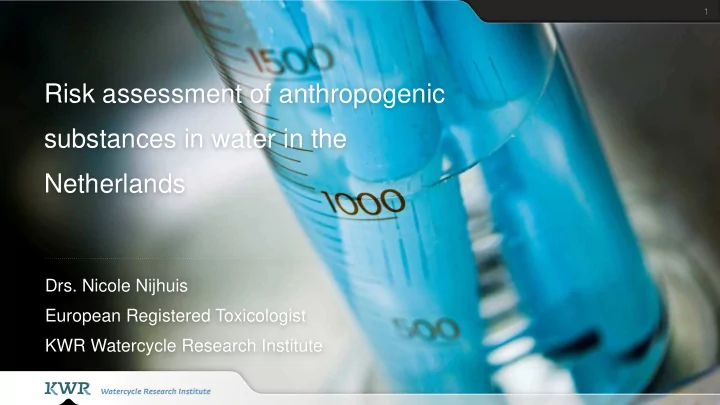

1 Risk assessment of anthropogenic substances in water in the Netherlands Drs. Nicole Nijhuis European Registered Toxicologist KWR Watercycle Research Institute
Milieu en Gezondheid BE febr 2019 2 Sources Dutch drinking water Global increase chemical production increase chemicals found in water Netherlands sources for water production 1. Groundwater (60%) 2. Surface Water (40%)
Milieu en Gezondheid BE febr 2019 3 Types chemical substances -Pharmaceuticals (emission: 140 ton p/y to surface water*) Antibiotics -Pesticides (17 ton p/y to water*) -Industrial chemicals (1600 ton p/y to water*) -Other: microplastics (in Netherlands not measured in drinking water, but in surface water) *Data 2018
antibioticaresistentie 4 Anthropogenic substances in water Increasing relevance due to reuse of treated wastewater
5 Antibiotics (A), Antibiotic Resistant Bacteria (ARB), Antibiotic Resistance Genes (ARG) ARG measured Crops Wastewater TP Drinking water Surface water Chemical factory Animal husbandry & fish farming Disinfection might promote ARG levels
Bridging science to practice 6 Monitoring Antibiotic Resistance Genes in water Drinking water production Surface water Drinking water production Ground water River Lek before and after ww treatment plant Isolate DNA & detect the genes using Q-PCR 5 sets of ARG (15 genes total) • ESBL Extended Spectrum B lactamase prod. bacteria • MRSA Methicilline Resistant Staphylococcus Aureus • VRE Vancomycin Resistant Enterococcus • Sulfonamide resistance genes • Tetracycline resistance genes
Milieu en Gezondheid BE febr 2019 7 1. Large routine monitoring programs Who: A. Directorate-General for Public Works and Water Management B. 10 drinking water companies (REWAB database) Where: A. Where large rivers enter The Netherlands B. Intakepoints for drinking water ( ≤ 800 chemicals)
Milieu en Gezondheid BE febr 2019 8 2. Risk based monitoring - Screening and prioritizing CEC’s (contaminants of emerging concern ) - Non routine measurements (KWR Watercycle Research) Three types monitoring: - measuring known substances (target screening) - measuring unknown substances (non-target screening) - Effect based monitoring KWR can measure in water: > 60 pharmaceuticals (metabolites) > 15 antibiotic resistance genes (ARG) (Q-PCR=advanced & efficient)
Milieu en Gezondheid BE febr 2019 9 INFORMATION EVALUATION SOURCES AND TOOLS DRINKING WATER GUIDELINE Legislation (Table 2-1) Risk Assessment Legal standard Adopt or recalculate Institutes (Table 2-1) Guideline value (§2.1) MEASURED DATA chemicals in water Calculate provisional drinking water guideline Meta-databases (Table 2-2) Established TDI, ADI, value Institutes (Table 2-2) RfD, DNEL , VSD (§2.2.1) Meta-databases (Table 2-2) Established LO/NO(A)EL Calculate acceptable daily intake and Institutes (Table 2-2) (§2.2.1) provisional drinking water guideline value OECD QSAR Toolbox (§3.1) AMBIT (§3.2) Workflow Other types of Calculate NOAEL, acceptable daily intake and Meta-databases (Table 2-3) 1. Apply (legal) guideline information provisional drinking water guideline value Institutes (Table 2-3) (§2.2.3) 2. Use measured data to calculate provisional PREDICTED TOXICITY OECD QSAR Toolbox (§3.1) AMBIT (§3.2) guideline value (e.g. ADI / TDI / NOAEL) ToxRead (§3.3) Structural alerts Chemical profiling Toxtree (§3.6) (§2.3.1) Chemotyper (§3.7) 3. Predict toxicity VEGA OECD QSAR Toolbox (§3.1) AMBIT (§3.2) 4. Toxicological Threshold of Concern (TTC) ToxRead (§3.3) AIM (§3.5) Identify suitable analogues Read across ChemMine (§3.8) Collect toxicity data (exposure level with negligible health risk, (§2.3.2) Toxmatch (§3.9) Predict endpoint of interest VEGA (§3.13) and metabolism and physic- conservatieve generic threshold value used for chemical properties OECD QSAR Toolbox (§3.1) substances which have no toxicity data. AMBIT (§3.2) QSAR Check applicability domain ToxRead (§3.3) (§2.3.3) Predict endpoint of interest T.E.S.T. (§3.4) VEGA (§3.13) TTC APPROACH Check exclusion categories See ‘Structural alerts’ TTC-based drinking water Indications for genotoxicity? T.E.S.T. (§3.4) guideline level (§2.4) Carbamate or organophosphate? In vitro bioassays Cramer classification
Milieu en Gezondheid BE febr 2019 10 Prediction toxicity in silico tools PREDICTED TOXICITY OECD QSAR Toolbox (§3.1) AMBIT (§3.2) - OECD QSAR toolbox (v 4.2) ToxRead (§3.3) Structural alerts Chemical profiling Toxtree (§3.6) (§2.3.1) Chemotyper (§3.7) - AMBIT VEGA - ToxRead OECD QSAR Toolbox (§3.1) AMBIT (§3.2) - ToxTree ToxRead (§3.3) AIM (§3.5) Identify suitable analogues Read across - Chemotyper ChemMine (§3.8) Collect toxicity data (§2.3.2) Toxmatch (§3.9) Predict endpoint of interest VEGA (§3.13) - VEGA and metabolism and physic- chemical properties OECD QSAR Toolbox (§3.1) Prediction hazard (several endpoints) AMBIT (§3.2) QSAR Check applicability domain ToxRead (§3.3) (§2.3.3) Predict endpoint of interest • Human health effects T.E.S.T. (§3.4) VEGA (§3.13) • Chronic toxicity • Ecotoxicity
Recommend
More recommend